 Big bounce requires a collapse phase (Large compression), followed by expansion (new Big Bang)
Big bounce requires a collapse phase (Large compression), followed by expansion (new Big Bang)One of the biggest breakthroughs of the 20th century was the definition of how really our universe is rich, vast and massive. The volume of the radius of about 46 billion light years contains about two trillion galaxies. Our observable universe allows us to recreate the entire history of our cosmic history, stretching back to the Big Bang, and probably even a little further. What about the future? What about the fate of the universe? Is it definite? This is what our reader wants to know:
You wrote that the universe is expanding at a slowing rate. I thought that the Nobel Prize was given for the discovery that the Universe is expanding with acceleration. Can you clarify leading theories? Are there great compression possibilities?
The best prediction of future behavior is in the past. But both people and the Universe can sometimes surprise us.
 After the Big Bang, the Universe was almost perfectly homogeneous, filled with matter, energy and radiation, and expanded rapidly. The evolution of the Universe at any time is determined by the energy density of its contents.
After the Big Bang, the Universe was almost perfectly homogeneous, filled with matter, energy and radiation, and expanded rapidly. The evolution of the Universe at any time is determined by the energy density of its contents.The speed of the Universe expansion at any moment depends only on two things: the total energy density existing in space-time and spatial curvature. If we understand the laws of gravity and how different types of energy evolve over time, we can recreate what the rate of expansion was at any time in the past. We can also study various distant objects located at different distances from us, and measure how much their light has stretched due to the expansion of space. Every galaxy, supernova, molecular gas cloud, etc. - everything that absorbs or emits light - tells the cosmic story of how the expansion of space stretched it from the moment it was emitted until the moment when we could observe it.
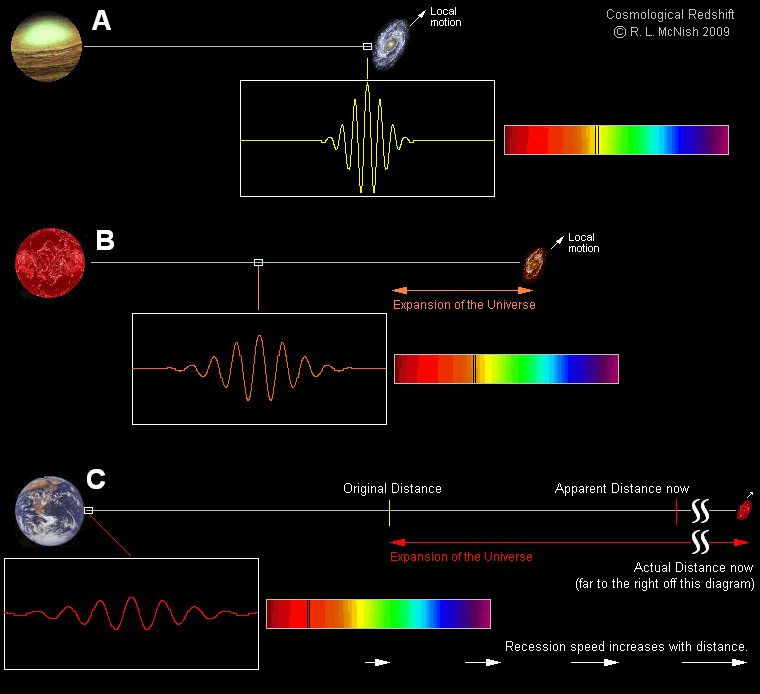 The farther the galaxy, the faster it moves away from us due to the expansion, and the more its light is experiencing a red shift, which is why we have to look at more and more long waves.
The farther the galaxy, the faster it moves away from us due to the expansion, and the more its light is experiencing a red shift, which is why we have to look at more and more long waves.From various independent observations we were able to conclude what exactly the Universe consists of. Three large and independent observation lines are:
- Temperature fluctuations of the background radiation, carrying information about the curvature of the universe, normal matter, dark matter, neutrinos, and the total density of the contents.
- The largest scale correlation between galaxies — known as baryon acoustic oscillations — gives very clear results for measurements of the total density of matter, the ratio of normal to dark matter, and the change in expansion rate over time.
- And the most distant and bright standard candles of the Universe, type Ia supernovae, telling us the rate of expansion and details of the evolution of dark energy.
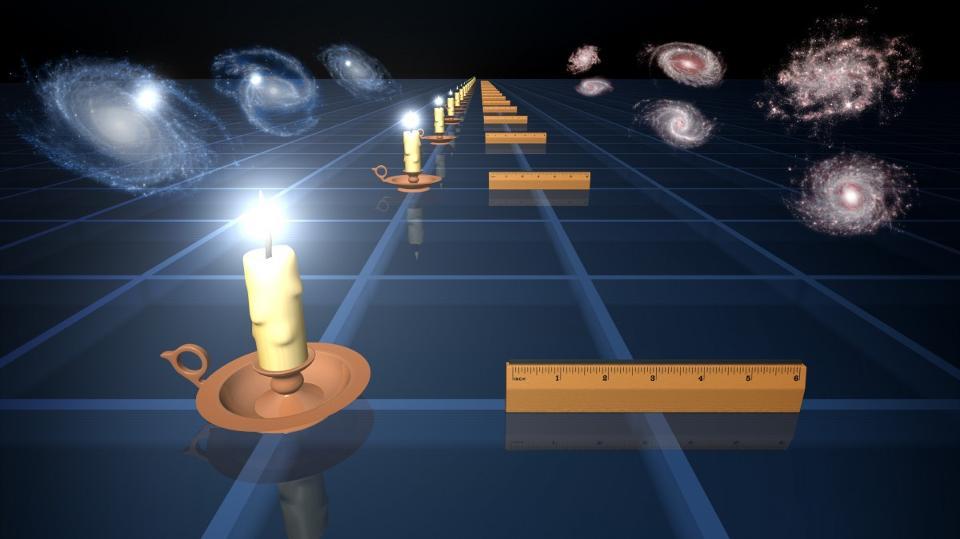 Standard candles (L) and standard rulers ® are two different techniques used by astronomers to measure the expansion of space at different distances and at different times in the past.
Standard candles (L) and standard rulers ® are two different techniques used by astronomers to measure the expansion of space at different distances and at different times in the past.All these testimonies together point to one consistent image of the universe. They tell us about what is in the universe today, and give us a cosmology in which:
- 4.9% of the Universe energy is contained in normal matter (protons, neutrons, electrons).
- 0.1% of energy is in the form of massive neutrinos (behaving like matter in recent times, and like radiation in early times).
- 0.01% of the energy exists in the form of radiation (photons).
- 27% of energy is in dark matter.
- 68% of energy is in the form of energy inherent in the space itself: dark energy.
They give us a flat Universe, with a curvature of 0%, a Universe without topological defects (magnetic monopoles, cosmic strings, domain walls, cosmic textures), and a Universe with a known history of expansion.
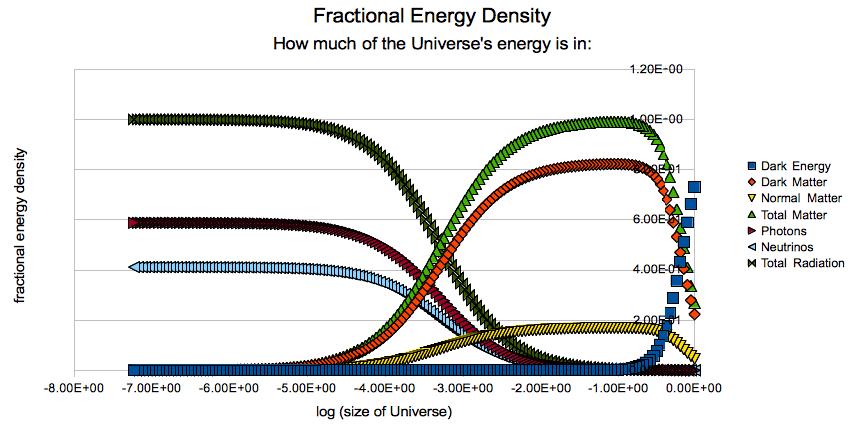 The relative importance of the various energy components of the universe at different times in the past. In the future, dark energy will approach 100% importance.
The relative importance of the various energy components of the universe at different times in the past. In the future, dark energy will approach 100% importance.The equations governing GRT are very definite in this sense: if we know what the Universe consists of today, as well as the laws of gravity, we know exactly how important each of the components was at any point in the past. At first, radiation and neutrinos dominated. Billions of years of dark matter and normal matter were the most important components. And in the past few billion years - and over time the situation will only get worse - dark energy will become the dominant factor in the expansion of the Universe. It makes the Universe accelerate, and this is where most people get confused.
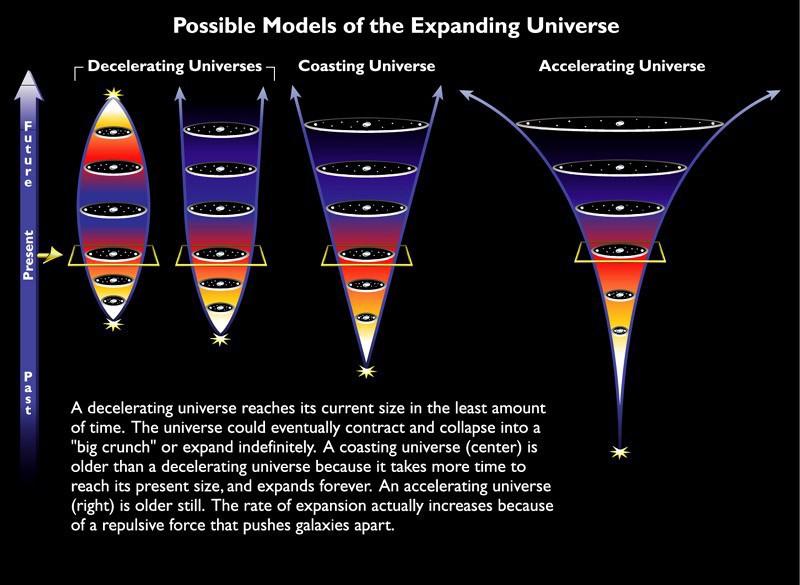 Variants of the fate of an expanding universe. Pay attention to the differences of different models in the past.
Variants of the fate of an expanding universe. Pay attention to the differences of different models in the past.In connection with the expansion of the Universe, we can measure two things: the speed of expansion, and the speed at which an individual galaxy moves away from us from our point of view. These parameters are related but not the same. The speed of expansion speaks of how the fabric of space-time is stretched. It is always estimated at the speed per unit distance, usually in kilometers per second per megaparsec, where megaparsec is 3.26 million light years.
 As matter (above), radiation (in the middle) and the cosmological constant evolve over time in an expanding universe
As matter (above), radiation (in the middle) and the cosmological constant evolve over time in an expanding universeIf there were no dark energy, over time the rate of expansion would fall, approaching zero, since the density of matter and radiation would approach zero with increasing volume. But in the presence of dark energy, this rate of expansion approaches the density of dark energy, whatever it may be. If dark energy, for example, is a cosmological constant, then the rate of expansion asymptotically tends to a constant value. But if so, then the speed of individual galaxies moving away from us will increase.
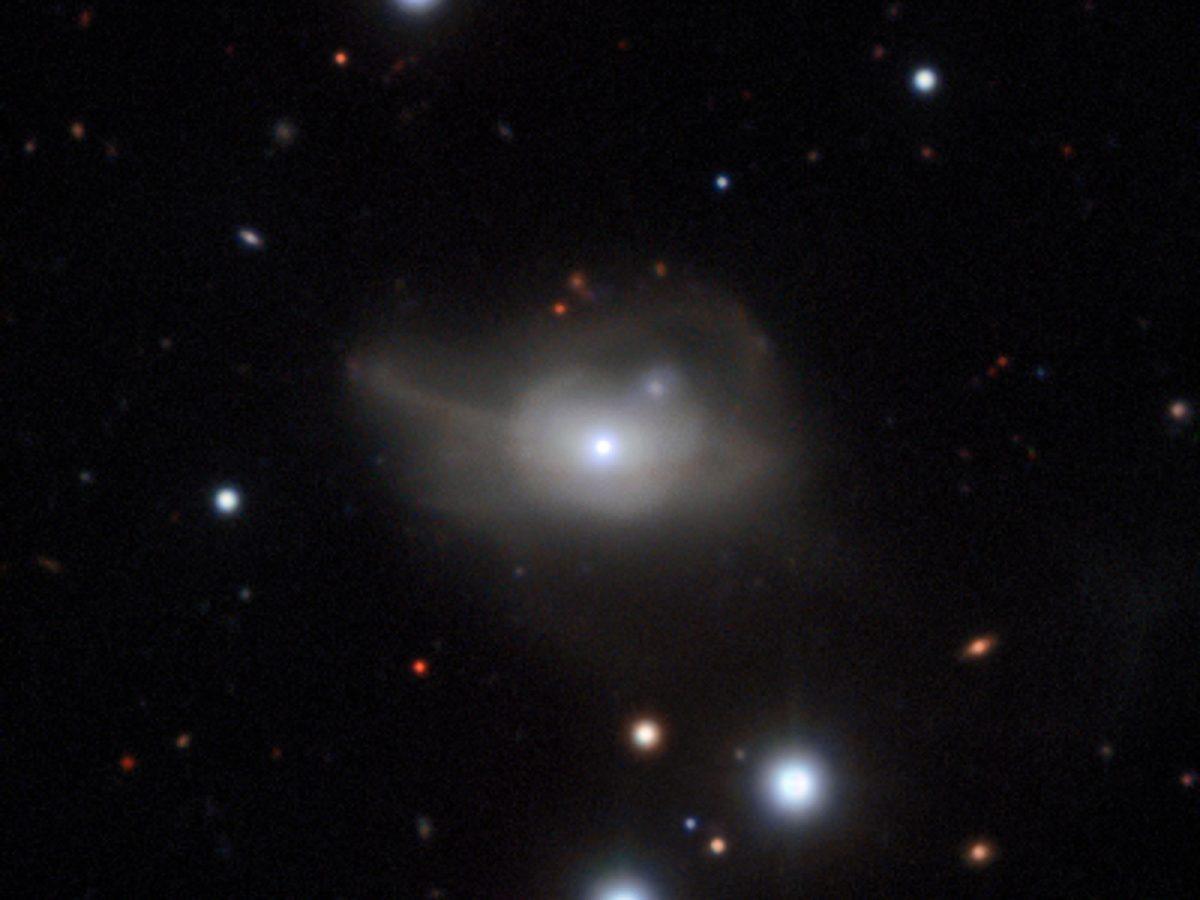 Markaryan 1018 Remote Galaxy in the Optical Range with Radio Data Overlay ( VLT )
Markaryan 1018 Remote Galaxy in the Optical Range with Radio Data Overlay ( VLT )Imagine that the expansion speed has a certain value: 50 km / s / mpc. If the galaxy is located 20 mpk from us, then from our point of view it will move away from us at a speed of 1000 km / s. But over time, when the fabric of space expands, this galaxy will be farther from us. By the time it is 40 mpk away from us, its speed of removal from us will be already 2000 km / s. After an even longer time, it will be ten times farther from us - at a distance of 200 mpk, and will be moving away from us at a speed of 10,000 km / s. By the time it moves away by 6000 mpk, it will move away from us at a speed of 300,000 km / s, faster than the speed of light. But it will go on and on; the more time passes, the faster the galaxy moves away from us. This is what is meant by the “accelerating” Universe: the expansion rate decreases, but the removal rate of individual galaxies increases with time.
 The composite of the ultraviolet, visible and infrared ranges of the project Hubble eXtreme Deep Field. The largest image of remote parts of the universe.
The composite of the ultraviolet, visible and infrared ranges of the project Hubble eXtreme Deep Field. The largest image of remote parts of the universe.All this coincides with our best measurements: dark energy is a constant energy density inherent in space. With the stretching of space, the density of dark energy remains constant, and the Universe will end its existence in the Big Freeze mode, in which everything that is not connected by gravity (it connects, for example, our local group of galaxies, our Galaxy, Solar System, etc.) scattered apart. If the dark energy actually turns out to be a cosmological constant, then the expansion will occur forever, and will lead to a cold and empty Universe.
 When astronomers first realized that the universe is accelerating, common sense said that it will expand forever. However, until we understand the nature of the dark energy better, other scenarios of the fate of the universe remain possible. They are depicted in the diagram: Large compression, perpetual expansion, large gap.
When astronomers first realized that the universe is accelerating, common sense said that it will expand forever. However, until we understand the nature of the dark energy better, other scenarios of the fate of the universe remain possible. They are depicted in the diagram: Large compression, perpetual expansion, large gap.But if the dark energy changes - theoretically it is possible, but not confirmed by observations - it can come both to the Big compression and to the Big Break. In Greater Compression, dark energy will weaken and change the sign, due to which the Universe will reach its greatest size, will unfold, and will shrink. It can even generate a cyclical Universe, when compression generates another Big Bang. If dark energy increases, the opposite situation will occur, in which the connected structures will eventually be broken off by the increasing expansion rate. But today's testimony confidently supports the “Big Frost”, in which the expansion rate will be constant forever.
The main goals of future observatories, such as ike the Euclid, WFIRST, LSST include measurements that will confirm whether dark energy really is a cosmological constant. And although the leading theory is in favor of the constant dark energy, it is important to consider all the possibilities, not excluded by observations and measurements. And even though Great Compression looks unlikely, it has not yet been excluded. With the advent of more data of better quality, we can still find interesting hints that reality is even more unusual than most of us thought!
Ethan Siegel - astrophysicist, popularizer of science, blog Starts With A Bang! He wrote the books Beyond The Galaxy , and Treknologiya: Star Trek Science [ Treknology ].FAQ: if the universe is expanding, why aren't we expanding